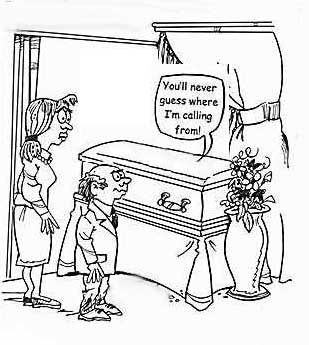Deactivated
They say that in
fifty years
social media
accounts of the dead
will outnumber the
living. They can be
deactivated, the
way utilities can be
shut off,
histories and caches cleared,
but they will live
forever on some
remote server, a
peculiar Akashic record.
Some people bury
their family members
with their cell
phones. The line is kept active
so they can call
and listen
to their loved
one’s voice
on voicemail. At
any time, when you walk
by a cemetery,
think of the ringtones and vibrations
humming beneath
your feet.
These stories proliferate,
the people who die
in their homes
and go unfound,
the bills on autopay.
Six years later,
the coroner is called
to cut free a body
fused to the floor.
We do not return merely to dust.
Our particles join to whatever surface will have
us,
destined to live on in bits and bytes
and dusty woodgrain.

“Akasha” in Sanskrit is derived from “kash” (to be visible) and in Vedic literature meant "open space, vacuity," then acquired the concept of sky or atmosphere. Philosophically it was employed to mean an ethereal fluid that pervades the cosmos. In Vedantic Hinduism, it was regarded as space, the 1st element from which appeared air (from which emerged fire or energy; from came water; from which earth was derived.) in some schools of Hinduism it is the 5th physical substance, the substratum of the quality of sound. It is the One, Eternal, and All Pervading physical substance, which is imperceptible. To Jains it is all-pervading, infinite space, the dravya (substance) that makes room for the existence of all extended substances and thus accommodates the other 5 (jiva [sentient beings or souls], pudgala [non-sentient substance, matter], dharma [motion], adharma [rest], adharma), and kala [time]); it has 2 parts, Lokakasha (which includes the material world) and Aloakasha (the space beyond, which is void). Three types of Lokakasha exist – Adho Lok, in 7 layers, where the inmates of Hell live; Madhya Lok, where human beings and other creatures live; and Urdhwa Lok, where beings of higher qualities live; at its top is Siddha Lok, the abode of liberated souls. The Buddhists divide akasha into limited and unlimited space. Helena Blavatsky incorporated much Indian philosophy into theosophy, the occult movement she founded in 1875. She regarded akasha as a life force; she also referred to "indestructible tablets of the astral light" that recorded the past and future of human thought and action, but she did not link it to the life force. In 1881 her fellow founder of the Theosophy Society, Henry Steel Olcott, wrote that "Buddha taught two things are eternal, viz, 'Akasa' and 'Nirvana': everything has come out of Akasa in obedience to a law of motion inherent in it, and, passes away. No thing ever comes out of nothing…. Early Buddhism, then, clearly held to a permanency of records in the Akasa and the potential capacity of man to read the same, when he was evoluted to the stage of true individual enlightenment." Two years later, after extensive correspondence with Koot Hoomi amf Morya, the 2 mahatmas who had inspired theosophy, Alfred Percy Sinnett, expanded Olcott’s notion of an “akashic record,” but the term itself was coined by Chartles Webster Leadbetter in his tome on clairvoyance. In this way, Akashic records became regarded as a compendium of all human events, thoughts, words, emotions, and intent throughout time, which are encoded in a non-physical plane of existence known as the etheric plane. In 1904 Annie Besant, one of Leadbetter’s associates (even after his temporary excommunication due to his advocacy of masturbation as a means of maintaining celibacy) made Rudolf Steiner the head of the Theosophical Esoteric Society for Germany and Austria, and he used the Akashic records concept extensively in a series of articles in his “Lucifer-Gnosis” journal for the next 4 years. Concentrating on European esoteric ideas rather than Indian ones, he split from the Theosophists and formed the Anthroposophical Society in 1913, and gave a series of Akashic Records lectures on a Fifth Gospel in 1913 and 1914. Based on his ideas, Ervin László conceived of an “Akashic field” as the substance of the cosmos in his 20004 book “Science and the Akashic Field: An Integral Theory of Everything.” According to Alice A. Bailey (1927), “The akashic record is like an immense photographic film, registering all the desires and earth experiences of our planet. Those who perceive it will see pictured thereon: The life experiences of every human being since time began, the reactions to experience of the entire animal kingdom, the aggregation of the thought-forms of a karmic nature (based on desire) of every human unit throughout time.”
ReplyDelete